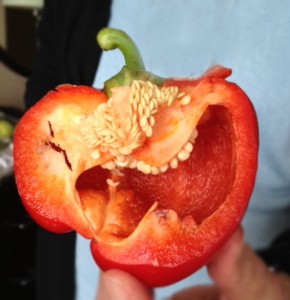
As Chef Marian, a person who blogs every day or every couple of days at least (depending on how busy I am), I have been asked more questions I don’t know the answers to. And that’s really fine in my world because I love that because it gives me an opportunity to do some research and know more.
I guess that stems from my days as a Radio Broadcaster and at one time, a News Director always interested in presenting all parts of a story, to let the audience make its’ own decision. These days we’ve got all kinds of Newscasters with all kinds of opinions, so I get to tell you what I really think. But all in all, I just really enjoy presenting new information I discover.
Here’s a chefs’ tip: Are you buying fresh herbs and watching them go bad in your fridge? Or forgetting about them, and when you finally go to use them they’re just not usable? Well, here’s an idea….. leave some out and take the rest and blend them with olive oil, then freeze them in ice cube trays. Any time you need fresh herbs, you’ve got ’em!
Speaking of that, do you know the difference between fresh vegetables and frozen? Is one better than the other?
FRESH IS BEST CHEF!
Yes, you’re right. But do you know why?
NO IDEA CHEF!
Well, it’s because they have to par boil the vegetable before freezing and some of the nutrients leach out into the water they par boil it in.
INTERESTING CHEF!
Why thank you. I thought this might be a fun blog!
Here’s another interesting question: If wine is peppery do they put pepper in it? And what kinds of wine should I be looking for, if I like that? According to wine expert Robert Parker, “a peppery quality to a wine is usually noticeable in many Rhône wines that have an aroma of black or white pepper and a pungent flavor”. So we’re talking about an aroma here…. not pepper added to the wine.
How did horseradish get its’ name? According to horseradish.org “it originated in Central Europe…. In German it’s called ‘meerrettich’ (sea radish) because it grows by the sea. Many believe the English mispronounced the German word ‘meer’ and began calling it mareradish. It eventually become known as horseradish…. believed to denote large size and coarseness. Radish comes from the Latin radix, meaning root”.
Moving on to questions about oil….
One of our biggest problems is we hear about something today and tomorrow, it’s a whole new story.
In the beginning, Canola oil was thought to be good for you. But Canola Oil is genetically modified. While it is true that I have talked to manufacturers that are starting to create organic Canola Oil, which immediately rules out the genetic modification, (and I’m pretty excited about that), most restaurants you go into these days (if you’re lucky and can get them to admit to it and not just give you a generic answer like ‘vegetable oil’….) are using Canola Oil. And that’s not really good for you.
But let’s go onto some research about your personal use of oil at home.
What oils have high smoke points and at the same time are actually good for you?
NOT SURE CHEF!
Try Rice Bran Oil. According to Wiki it helps with cholesterol, menopause and the antioxidant effect is stable even when the heat is on high! Personally, I prefer Grape Seed Oil. Just remember: think low and slow, maybe even up to a medium flame only, when using olive oil to cook with. That’s my opinion.
And I guess the Olive Oil Source agrees with me:
|
Type of Food
|
Cooking Temperature
|
|
High water content: vegetables, potatoes, fruit …
|
Medium (266-293ºF or 130-145ºC)
|
|
Coated in batter, flour or breadcrumbs, forming a crust
|
Hot (311-338ºF or 155-170ºC)
|
|
Small, quickly fried: small fish, croquettes
|
Very Hot (347-374ºF or 175–190ºC)
|
Sorry folks. I still wouldn’t cook with Olive Oil on high. If you notice what they are calling Hot or Very Hot is still below the smoke point temperatures of some of the other oils listed below. I do like the fact that this group does give you a chart to show you the ‘smoke point’ temperature qualifying that the “smoke point for a vegetable oil will vary according to the variety and growing conditions, and how the oil was produced. Various manufacturers and sources cite different numbers”.
|
Type of Oil
|
Smoke Point Temperature
|
|
Grape Seed
|
485ºF or 252ºC
|
|
Avocado
|
480ºF or 249ºC
|
|
Sesame
|
410ºF or 210ºC
|
|
Canola
|
400ºF or 204ºC
|
|
Macademia
|
385ºF or 196ºC
|
One more topic, then it’s time for me to go. Have you ever wondered how much protein you should eat?
Like did you know that Portabella and Shiitake mushrooms have protein? According to FitDay: “They are very low in calories, high in fiber and protein (~37%), and an excellent source of antioxidants which help neutralize free radical damage in our bodies”.
I think we’re probably over eating when it comes to protein. Go have a look at the Vegan pyramid table to see how much proteins you need and what foods we consume that actually have protein that aren’t ‘standard’ (the one’s that are public knowledge). And remember that the size of your palm is the most amount of protein you should be eating in any one sitting!
More on that another time.
Ok. Stick a fork in me, cause I’m done!
Happy Eating,
Chef Marian